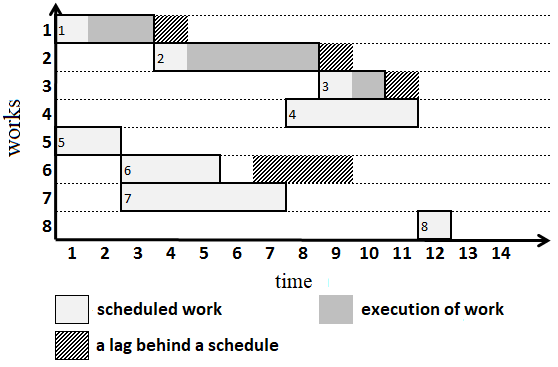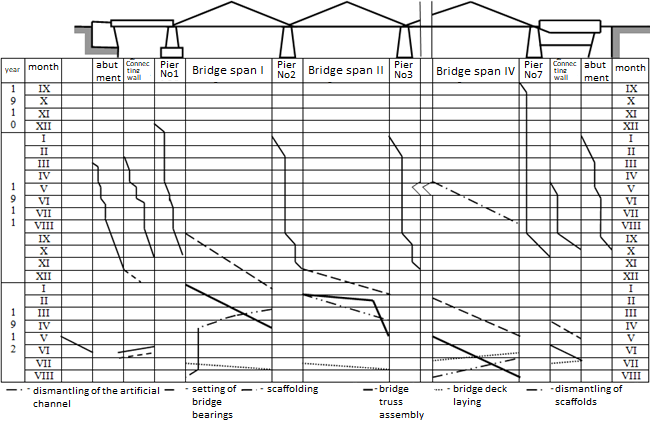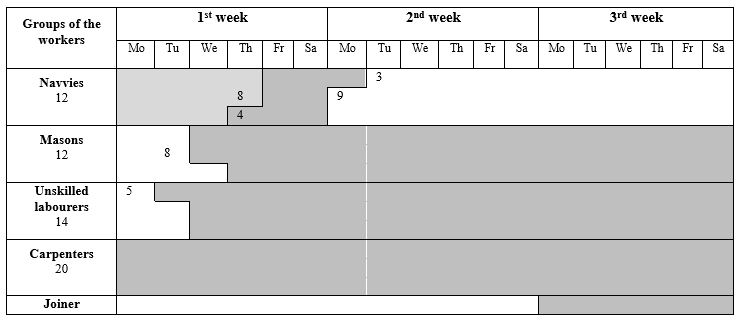Abstract
The history of mankind can be viewed through the “prism” of projects that were implemented in a certain era. The research results of the Russian history of project management allow us to identify three main stages of the project management evolution process. The first, pre-revolutionary, stage is associated with the origin of the basics of project activities: the formulation of basic concepts, the formulation of the first norms of calculations, the development of the practice of using models of display of production processes. It was the period of formation of the theory and practice of project activities in construction, production activity, State administration. Since the 11th century in Russia, there were the first regulatory and technical documents on technics and technology of construction, and the first standards. Facilities construction according to drawings applied in practice. Since the 17th century, the regulatory base for the calculation of the number of workers and materials, allowing to monitor the progress of work and assess their quality, had been gradually developing. Since the 19th century, a labor-training program in drawing and estimating business had begun, a standard architectural and construction project engineering had developed. Along with foreign engineers, Russian specialists were actively developing new planning models, including scheduling. Production management and labor organization journals began to be published, the first professional project organizations were created. By the end of the pre-revolutionary period of Russia, the considerable experience in project business as an independent stage of creation of fixed and non-productive assets had been accumulated.
Keywords: Construction businessestimate normsproject businessproject engineeringschedulingstandard construction
Introduction
Today, the theory and practice of project management is undergoing significant changes: the glossary is expanding, instruments and methods of project work are improving, new project technologies are developing (Sokolova, Grebenyuk, & Sokolov, 2018). However, to understand the new, including in project management, it is necessary to learn the lessons of the past.
A new round of intensive development of project management in Russia is just one of the stages in the Russian history of project development. By their nature, project technologies are universal and therefore capable of interdisciplinary transfer. The study of the sequence of development of project practice in various fields of activity allows to identify and understand the internal links of the project-oriented approach, to understand the general scheme and the main trajectory of project management.
The study of the chronology of the Russian history of project management is designed to identify patterns of territorial development, considered in the unity of socio-economic and managerial aspects. Ultimately, it is the continuity of project knowledge that determines the effectiveness of project management, including in territorial development.
Problem Statement
The history of mankind can be viewed through the “prism” of projects that were implemented in a certain era. Many built structures serve as vivid examples of the concentration of spiritual and intellectual efforts in the implementation of the great projects of the past (Il'ina, 2011).
The research results of the Russian history of project management allow us to identify three main stages of the project management evolution process (Voropaev, 2008):
1. Pre-revolutionary – the origin of elements, concepts, norms of calculations, display models of production processes, etc. in the field of knowledge of project management, and their application in practice;
2. Soviet – creation of a system of centralized planning, program-oriented and goal-oriented approach, management structures and complex of documents, network planning and automated management systems, and other elements of project management methodology;
3. Modern – stage of evolution of professional project management based on a contemporary view and new advanced technologies; systematic approach to the project management methods; large-scale implementation of project-oriented approach to the implementation of projects and programs in various areas of the goal-oriented activity throughout the country.
Research Questions
Each stage of project management evolution in Russia had made an invaluable contribution to the establishment of the project school. Undoubtedly, the Soviet stage with its program-target approaches, systems of structural planning and scheduling, elements of automated management, etc., is the stage, which is the most saturated with bright project achievements.
However, it is the pre-revolutionary stage that not only forms the theoretical and methodological basis for the development of the project business, but also focuses the attention of researchers on the possibilities and features of the project approach in the field of State and municipal management and in the field of territorial development.
Purpose of the Study
The purpose of the study is to identify the Russian experience of the project business, accumulated by the beginning of the 20th century, which allowed to ensure the widespread implementation of the project-oriented approach in technique, production and social spheres, and, finally, in the management of territorial development.
Research Methods
Chronology of the events and the examples of the projects, corresponding to these stages, are presented in Table
The project and construction business of the Slavic tribes was at a relatively high level. Under Yaroslav the Wise, in the 11th century, “Building bylaw” was published, it can be considered as the first Russian technical guidance document for construction engineering and technologies, high level of which was resulted in the use in the 12th century of typical projects (each joisting had ticks – the ordinal numbers on the wall from the bottom up). This allowed the builders to produce wood blanks on-site altogether, deliver them to the construction site and quickly assemble the building (a prototype of prefabricated construction). The idea of such a prefabricated construction was widely used in the reign of Ivan the Terrible in the restoration of Moscow after “major fires” (Anikin & Carev, 2015).
In addition, under Ivan the Terrible, in military and construction business the first standards were applied, the fact of construction of an architectural structure according to drawings (the Assumption Church in the Alexandrovsky Sloboda (Alexandrov)) is registered for the first time.
In the 17th century, the detailed project engineering in the construction industry began, the instructions on the planning of drawings of the manufactories appeared (Zolotareva, 2017). In the normative documents of that time, the first instructions on “inventory management” appeared. For example, in the “Charter of military, cannon and other affairs...” written in 1607-1621, it said “... as it happens to all sorts of stocks, that will be of use to this city business, to stock and produce in advance, that there will be no paucity during the affair...” (Voropaev, 2008).
Since the beginning of the 19th century, the “quality management” element has been formed in project management. For example, in 1806, the Construction Committee was established as part of the Ministry of Internal Affairs, which had the responsibility “to monitor over construction and to resolve difficulties encountered by architects and construction managers directly on-site” (Voropaev, 2008). Many strict nominal and Senatorial executive orders concerning construction and numerous of reference books had been accepted. For example, on May 15th, 1810, an executive order “About the construction of not a building without a plan”, and on November 3th, 1810 – the executive order “About the prohibition to make any deviations from the confirmed city plans without special permission” were published (Anikin & Carev, 2015).
In 1811, the first reference book of the “Determined register” was published, in which the normative base for calculation of number of workers was compiled, the seasonality of construction was approved, the calculation methodology of the approximate amount of the daily attendance of “artisans of each kind,” the application of tools and devices was proposed. The usage of the reference book in the construction industry allowed to perform the calculation of specialized brigade and to manage time in the process of project implementation.
From the beginning of the 19th century specifically, detailed organizational and technological documentation for the production management and human resources was preparing for the construction of extra complex and large structures.
In 1813, for the first time in the history of construction, the Russian engineer, Brigadier General Voronov applied stop-watch reading in the regulation of trenching and transportation of soil, thus laying the scientific basis for the management of production processes in the construction of buildings and structures, and, later, in the industrial production (Kolyasnikov, 2017).
In 1825, “Regulation on the amount of material”, containing the tables of requirement of materials and labor, was published. In short order, “Determined register”, “Determined Regulation” and “Building bylaw”, which provide consumption rates of materials and labor, recommendations for use of the methods of organization and acceptance of work, was published. These regulatory documents allowed to control the progress of work on construction sites, to assess their quality.
Since the middle of the 19th century, engineering educational institutions began to train specialists in draftsmanship and budgeting. Standard architectural and construction project engineering evolved. Albums of standard drawings (“model”, “normal”, in the terminology of the time) of bridges of different projects, public, residential, military buildings and structures, churches for 1000, 500 and 200 parishioners, rural residential houses, were made (Anikin & Carev, 2015).
In the late 19th – early 20th centuries, there was several private companies in Russia, dealing with the project engineering: “Technical office of the engineer A. V. Bari” (later “Construction office of the engineer A. V. Bari”) – the project engineering of steel structures; the Merchant house “YUlij Guk and Co” – the project engineering of reinforced concrete; the Merchant house “V. Zalesskij and V. Chaplin” – the project engineering of heating and ventilation system. Also, there were the combined firms engaged in project, construction and operation of buildings and structures: “Builder”, “Architect”, “Engineer”, etc. (Anikin & Carev, 2015).
Time schedules that facilitate the management of time and resources in production sector and in the construction of large buildings were used abroad since the end of the 19th century (Marshev, 2019). Diagrammatical models of planning, accounting and monitoring of all resources, proposed by H. L. Gantt, C. H. Kneppel, J. Mut and J. Thompson, had the biggest application in the practice of project management of that time.
In 1891, Henry Lawrence Gantt, a close associate and follower of Frederick Winslow Taylor, the “father of scientific management”, developed a diagram consisting of segments and points as a means to represent the duration and sequence of tasks in the project (Robles, 2018). The form of the linear time schedule proposed by him (Figure

However, the model “Gantt Time schedule” in the form of a linear schedule had not only advantages, but also certain disadvantages (Redfern, 1995). Therefore, Russian engineers and designers were actively involved in the search and development of new models of time schedules (Mironov, 2018). So, in 1910-1912, a unique model of time schedule, later called “sequence diagram”, which allowed to strongly link together the individual works not only in time but also in space, was developed for the construction of the bridge over the Oka in Murom (Figure

The sequence diagram was supplemented by a detailed explanatory note, including tables, schedules and costs estimation diagram (Figure

Thus, by the end of the 19th century, Russia had accumulated considerable experience of project business as an independent stage of creation of fixed production and non-production assets:
project departments and offices were created;
engineering surveys were conducted;
training of qualified personnel for all stages of project was carried out;
architectural and construction project engineering was carried out;
space-planning and project decisions were made;
engineering development of all elements of construction was conducted;
preparation of budget estimates was carried out;
supervision of progress and quality of the work was performed;
standardized package of project and estimate documentation was taken its shape.
However, the responsible and common use of the project approach in technology, business and social sphere was a phenomenon of the last third of the 20th century. But at the beginning of the 20th century there was a huge upturn in project development, the most powerful – in engineering business (Maslova, 2013).
Findings
By the beginning of the Soviet stage, there was no unification of technological, space-planning and project studies, there were no estimated standards and methods for determining the estimated prices for construction materials and resources. The need to intensify the socio-economic development of the country had made the creation of State and scientific organizations a topical issue. So, at the beginning of the 1920s approximately 20 journals, concerning production and labor management, were published, the first complex project and survey organizations were created (Voropaev, 2008):
The Research and Project Institute of communications, which was soon renamed as the Research Committee;
Central Institute of Labor;
Bureau of scientific labor management, affiliated to Gosstroy;
Project and consultative organization Orgstroj";
Technical Bureau for steel structures, established on the basis of the company "Bari";
"Gosinsilikat" for binding materials (1922);
"Hleboprodukt" for grain processing facilities (1923);
Project office "Donugol'" for coal mines (1925);
Project Bureau for industrial transport (1926).
Conclusion
At the beginning of the 20th century, the formed theoretical and methodological basis for the development of project business allowed Russian scientists and practical workers to carry out successful experiments of long-term scientific planning, which served as the basis for further work in the development of projects for the national economy.
In the 1920s, the universality of the accumulated project knowledge helped to implement the transition to a New Economic Policy (NEP), which helped in the restoration of industry, agriculture and transport, destroyed by the Civil war, contributed to the development of urban utility service.
The development of practical methods of program-oriented and goal-oriented management of P.A. Stolypin, subsequent reforms and the “Long-term program of socio-economic development of Russia”, preceding the revolutionary events, formed the basis for the successful implementation of the GOELRO plan, the first five-year plans for the development of the national economy of Soviet Russia.
References
- Anikin, Y. V., & Carev, N. S. (2015). Design business in construction. Yekaterinburg: Ural University Publishing House.
- Il'ina, O. N. (2011). Project management methodology: formation, current state and development. Moscow: INFRA-M.
- Kolyasnikov, V. A. (2017). Significant and Basic Innovations in Urban Planning. IOP Conference Series: Materials Science and Engineering, 262(1), 012117.
- Marshev, V. (2019). Formation of management thought in Russia and early USSR from the 1800s to the 1920s: Heroes and their creations. Journal of Management History, 25(3), 285-303.
- Maslova, S. V. (2013). Project management. Tomsk: Publishing House of Tomsk Polytechnic University.
- Mironov, B. N. (2018). Imperial, Soviet, and post-Soviet modernization. Bylye Gody, 48(2), 647-676.
- Redfern, M. A. (1995). Gantt chart variations to meet the needs of modern project control and management information. 3rd International Conference on Advances in Power System Control, Operation and Management (APSCOM 95), pp. 119-123. Hong Kong: Institution of Engineering and Technology.
- Robles, D. V. (2018). Visualizing Certainty: What the Cultural History of the Gantt Chart Teaches Technical and Professional Communicators about Management. Technical Communication Quarterly, 27(2), 1-22.
- Sokolova, A., Grebenyuk, A., & Sokolov, A. (2018). Twenty years of S&T priority setting in Russia: lessons learned. Foresight, 20(5), 449-466.
- Voropaev, V. I. (2008). History and trends of project management. Moscow: Federal State Budgetary Educational Institution of Further Professional Education GASIS.
- Zolotareva, M. (2017). New trends of urban development in Russia in the 18th century. Journal of Architecture and Urbanism, 41(1), 71-77. https://doi.org/10.3846/20297955.2017.1296792
Copyright information

This work is licensed under a Creative Commons Attribution-NonCommercial-NoDerivatives 4.0 International License.
About this article
Publication Date
31 December 2019
Article Doi
eBook ISBN
978-1-80296-076-1
Publisher
Future Academy
Volume
77
Print ISBN (optional)
-
Edition Number
1st Edition
Pages
1-1056
Subjects
Industry, industrial studies, project management, sustainability, business, innovation
Cite this article as:
Voiku*, I. P. (2019). Pre-Revolutionary Stage Of Russian History Of Project Management Evolution. In I. O. Petrovna (Ed.), Project Management in the Regions of Russia, vol 77. European Proceedings of Social and Behavioural Sciences (pp. 219-226). Future Academy. https://doi.org/10.15405/epsbs.2019.12.05.26
